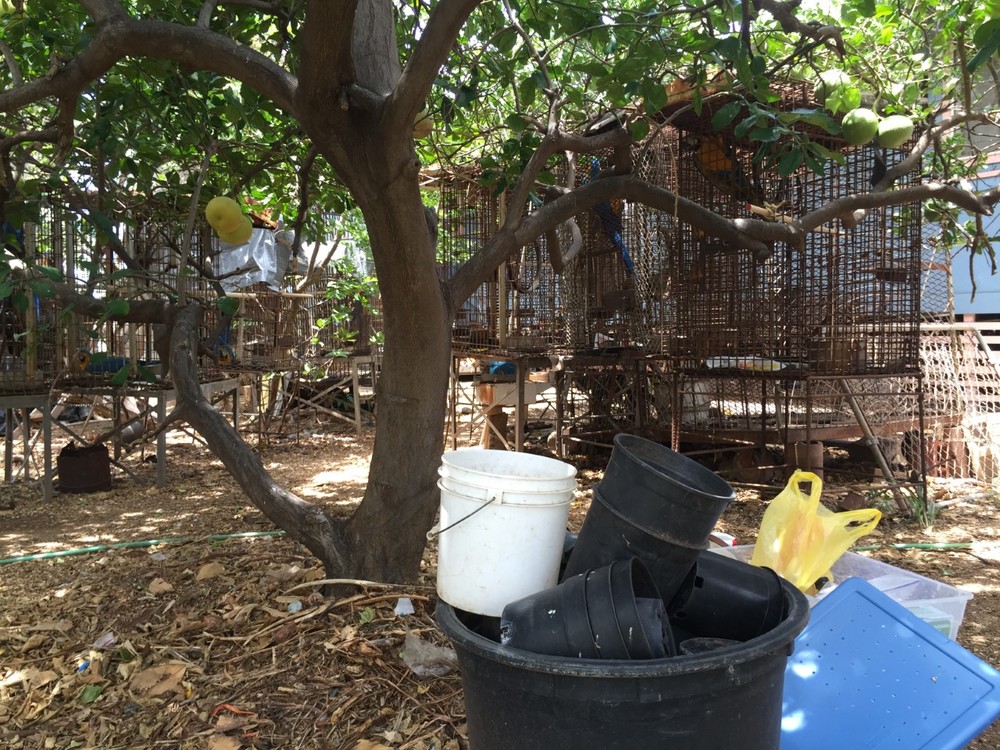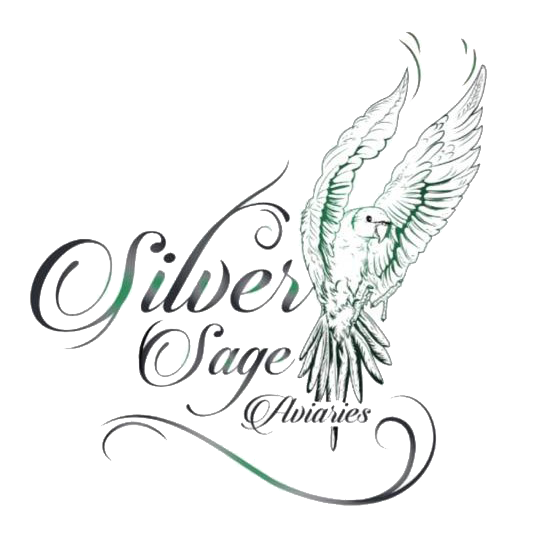Sometimes when working with parrots we experience things that make us sick, and sometimes we are blessed to be able to step in and do something to help.
Last year I went with some club members to a property where several macaws were being kept. The owner had died, and the caretaker was looking to sell the birds. That is all I knew. I expected to see a breeding setup that had once been functional but now was perhaps a bit overrun, and meet a caretaker who felt she could no longer meet the needs of the birds. This is not what we found.
In the yard of a house that no one lived in, we found many cages, covered every inch in rust, cobbled together from various grates and wires, sharp edges and gaps everywhere, and coated in droppings. It seemed a miracle that no birds had died from injuries received on the cages or from bacterial infections. Then I noticed the empty cages…
The cages were very small, several small enough that the birds in them had no chance of opening their wings all the way. There was not a stick or dowel in a single cage, rather in the center of each was a metal wheel rim that seemed to be from an old bike, swinging on a chain. This seemed to be the only perch these birds had ever known. Cockroaches and mice skittered everywhere, and algae as thick as felt covered the insides of the water bowls, all of which stank. Sunflower seed hulls carpeted the ground. Most of the cages had some shade, but several were in direct sun with no space for the bird to take shelter from the tropical heat.
The birds were Blue and Gold Macaws. Most were fully feathered, but telltale yellow feathers in the wrong places plainly indicated severe liver issues. Several of the birds had painful red shades to their faces that should have been snowy white, and the skin around their nares was loose, warped, and swollen. One bird hung upside down nearly the entire time, banging his head against the side of the cage and flipping his wings every which way in a fashion that seemed to indicate mental deficiencies. Another bird has a mangled beak as if he had shoved it between the bars of his makeshift cage and snapped it off somehow.
The owner had indeed died, but it had been over a year before. Before passing he told the caretaker not to sell any of the birds for less than $1000 each. She had tried many times, and many people had come to look at them, but each time they left empty handed at seeing the condition of the birds. The caretaker had decided to lower the price to $200 or less per bird, and a local bird lover had contacted us about the situation. The club was concerned that at such a low price point, the birds would be sold to people who would not take good care of them. We were right.
Shortly after we arrived on the property, the caretaker arrived with a family, and sold them one of the macaws. A friend of mine told them point blank that the bird needed immediate veterinary care or he would likely die. The man laughed, and with various profanities declared that the bird had survived in this state for this long, it would be fine continuing to do so. The family began moving the small cage into the back of a truck. When this caused the bird to panic, scream, and flail, the family laughed, and shook the cage. I retreated behind a row of cages to compose myself. We could not afford to offend or alienate the caretaker, as she had not yet agreed to release the birds to us. She was proud of the birds; they looked good to someone who doesn’t know the signs, and has no concept of proper living arrangements.
When we arrived there were 14 birds on the property. One left with the reckless family who informed us they intended to use him as a lawn decoration, and two more had been sold to an unknown party without our knowledge. The remaining 11 birds were “purchased” by the club. The fate of those three will haunt me for the rest of my life.
As it turns out, the only two birds to share a cage, far in the back of the yard, were the original birds. All the rest were their offspring. The caretaker informed me that “Even in the hurricanes, the bad hurricanes, even in the 80’s, they stay here, they never move, go inside, nothing, they just stay, all fine, all good.” She seemed to be trying to explain that the birds were fine and did not need care. This gave us a base age to work on; these birds were probably near 30 years old or older. We also learned that they were all in the cages they had “always been in,” making the condition of the macaw in the smallest cage in the back even more appalling. His head and tail could nearly touch the floor and ceiling at the same time, and his wings had likely not been extended since he was removed from his parents around the time my parents met, or earlier.
We began by feeding actual food. Clean seed, pellets, nuts, and fresh fruit and veggies. We scrubbed out the putrid water dishes, at least those that we could remove. Some were bolted and rusted to the cage indicating years of not being moved. We inserted perches and again held back tears as not a single bird knew what to do with them. We rigged tarps and scraps of metal to protect the most exposed birds from the sun, and planned a feeding schedule for the birds until we could remove them. Some of the members went to the hardware store to buy chains and locks, suspecting it possible that the caretaker might return to sell the birds to other people now that she had our cash.
Later that week other members of the team were able to do the actual extraction and move the birds to a safe location. I was not able to be there due to work. The bird with the mutilated beak was taken to the vet where he quickly accrued nearly half a grand in expenses with almost no actual treatment. His medical expenses were paid entirely by a close friend of mine who also took on his medical care and general upkeep until he could be sent to his family. He, along with his family, was dangerously malnourished and frail. His veins began to collapse as they drew his blood. His beak had to be trimmed severely in an attempt to shape it properly after his injury, and he may need a prosthetic. His brother has so many yellow feathers from liver damage that he looks pied.
All of the birds except Bugsy, the one with the mangled beak, were sent to Washington State to live out their lives safely in an aviary all their own. Bugsy was released to a prominent parrot rescuer who was to travel with him once he was cleared by the vet to fly. We are still hoping to hear that she has followed through and reunited him with his family. All Photos courtesy of a rescue volunteer.
BLUE AND GOLD MACAWS IN HAWAII


Leave a Reply